Revival is always happening in the jewelry world, but archaeological revival had its heyday in the second half of the 19th century, when all kinds of treasure was being excavated all over Europe. That period was a high point for craftsmanship and gold work, but just as interesting is the way this elaborate style fit with the fashions of the time.
Victorian women piled it on. With all those layers of clothing, they had more places to attach and drape things than we do today – including their elaborately pinned and piled hair.

A couple paintings in the 2017 exhibition Past is Present: Revival Jewelry at the Museum of Fine Arts in Boston demonstrated the way Revivalist jewels were worn, at least by the bohemian crowd. “Bocca Baciata (Lips That Have Been Kissed),” a pre-Raphaellite portrait painted by Dante Gabriel Rosetti in 1859, shows his favorite model wearing a Revivalist gold necklace and earrings, and what a appears to be a third earring attached to her abundant locks. I’ve read that Rosetti collected Revivalist jewelry himself, which explains the reverence with which he painted it.
“This wasn’t just a movement that was happening in jewelry. It was a larger movement,” said Emily Stoehrer, the MFA curator of jewelry who organized the exhibition. “The paintings gave me the opportunity to show what these ornaments looked like being worn. It’s important for people to understand these beautiful objects on their own, but also how they relate to the body.”
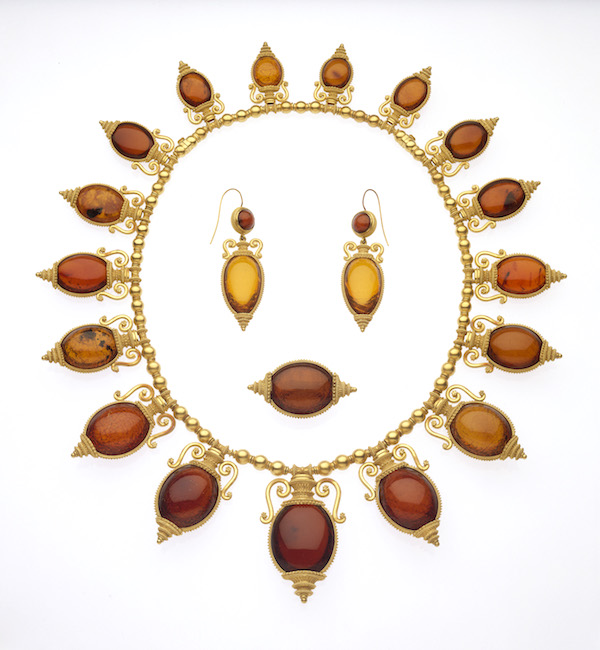
Like other Revivalist jewelers, Rome-based jeweler Fortunato Pio Castellani had amassed his own world-class collection of ancient jewels by the mid-1800s, and used them to study and perfect ancient gold-working techniques. But while Castellani became known for technique and craftsmanship, what really set them apart was their fresh approach to design.
“They did not feel confined to a meticulous copying of the original,” Mascetti and Bennett wrote in Celebrating Jewellery. “They relied instead on a sophisticated reinterpretation of the look and feel of the antique… so that the jewels were now invested with a confidence and vibrancy that was entirely unique.”
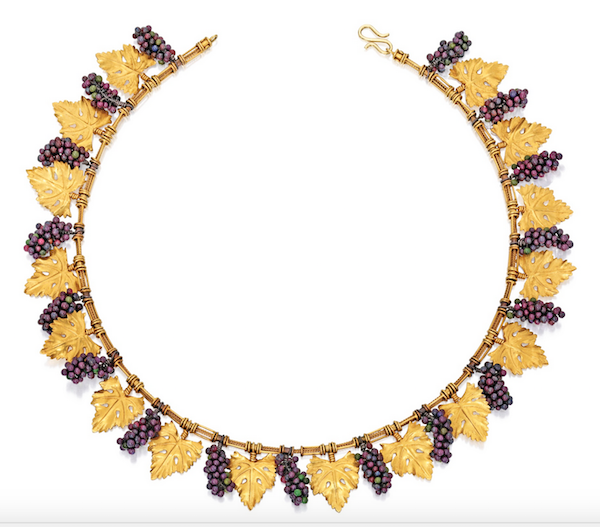
Most of the works on display were donated in the late 19th century by the museum’s local patrons. Those Bostonians probably discovered Castellani on their own “grand tour” of Europe, a ritual that became de rigueur for wealthy Victorians.
By then, Italy was rife with excavated treasure from the country’s glorious past, starting with Pompei in the 18th century and continuing with excavations in Rome and Tuscany. A tourist could easily buy ancient artifacts as souvenirs then. It’s no accident that Castellani set up shop across from the Trevi Fountain, tourist central in Rome.
“They were absolutely catering to a grand tour audience,” said Stoehrer. “But the Castellanis were also involved with the fight for unification of Italy, so I think there was a strong political motivation in buying and wearing their jewelry. By the 1860s, they stopped importing fashionable jewelry from Paris and started to focus wholly on Revivalist jewelry.”
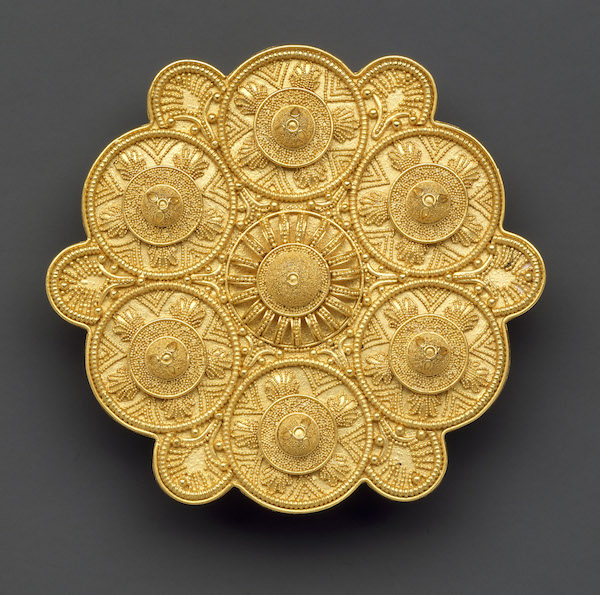
Even more than the micromosaic we looked at with their Egyptian revival jewelry, Castellani is known for reviving and perfecting granulation. There are some wonderful examples of Castellani granulation in Past is Present, including this exquisitely detailed brooch from 1858 and the amber and gold suite designed with the urn motif (above).
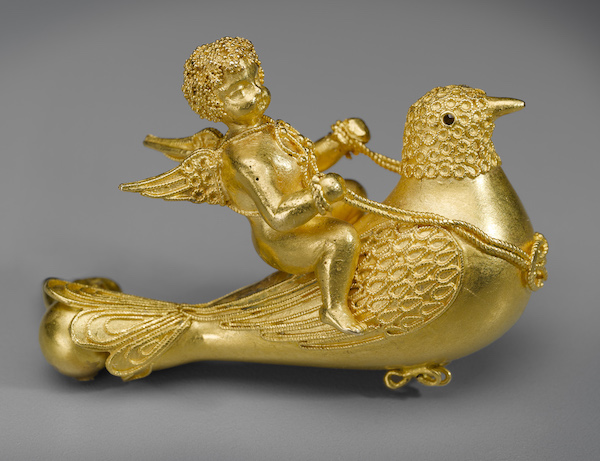
Others were making beautiful jewels in that style as well, including Giacinto Melillo, who contributes a gold brooch made in the 1870s, depicting Erotes riding a dove (above).
But the revivalists weren’t all Italian. You’ll find an Etruscan Revival bracelet by Paris-based Ernesto Pierret made in 1860, intricately layered around a cow’s head motif. “That bracelet is a tour de force,” Stoehrer said. “Every surface is embellished in some way, kind of showing off all the techniques and designs that inspired the artist.”
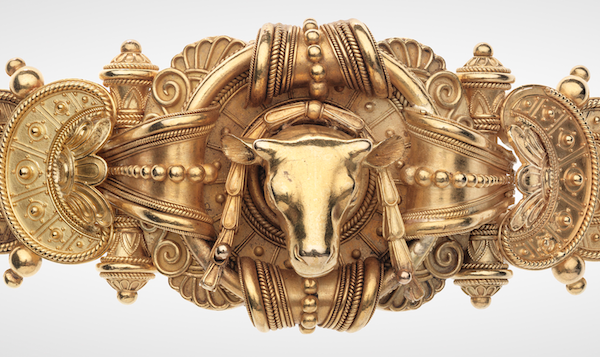
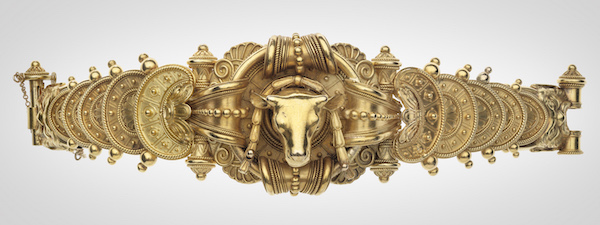
In the same case were more recent examples of revival jewelry, including an enameled sea creature with granulated tentacles by American goldsmith John Paul Miller. The technique of granulation went dormant after Revivalist jewelers such as Castellani, Melillo and British revivalist John Brogden failed to leave documentation. Miller helped bring granulation back to 20th-century jewelry after fellow jewelry artist Margret Craver unearthed a document for him, written by an archaeologist in Rome, detailing the secrets of the ancient technique.
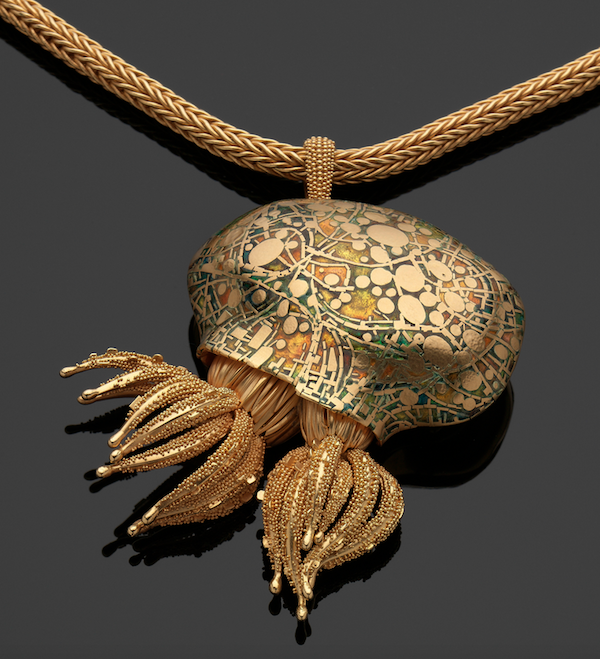
While Miller’s pieces are beautifully detailed, they stood out from the older jewels. “Seeing all these pieces next to each other – the ancient, the 19th century, and the more recent – you see the different skill of the artists and how minute the earlier artists were able to make the granules,” Stoehrer said. “The more recent pieces are much larger, not only in the size of the granulation but also in the size of the ornaments. The 19th-century and ancient examples are teeny-tiny jewels and the 20th and 21st century are quite large.”
Originally, Stoehrer planned to put these contemporary pieces in different cases, separating them by period, but in the end decided it was more interesting to show them side by side. “The scale itself is something you need to see firsthand,” she says.

